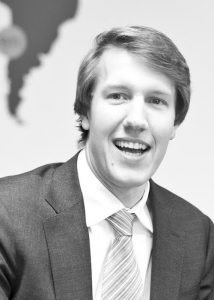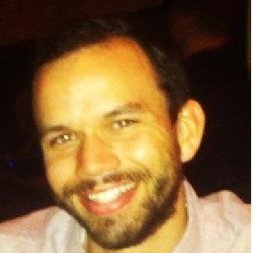Armin Hoebart’s Journey from Haas to Apple

Austrian-native Armin Hoebart worked in consulting before coming to business school for a small company in Europe that served very traditional companies in the manufacturing industry. “I came to Haas because I wanted to explore multiple options,” he says. “I knew I did not want to go back into consulting or to do finance, but that was about it.”
Hoebart echoes Anglade and Chin in praising the exploration the Career Management Group encouraged him to do. “They were great about allowing me to explore different routes without pushing me into any one direction,” he says. To start with, Career Management helped connect Hoebart with area startups, enabling him to work with one during his first year.
Career Management also helped Hoebart recognize that he was looking to make two switches—country and industry. He wanted to work in the United States upon graduation rather than returning to Europe, and he wanted to shift from the slow-paced manufacturing industry to a very fast-paced industry. “The advice I received—and I am very grateful for it—was to keep operations a theme,” he says. From his tech undergraduate studies to his operations work as a consultant, the fact that he is a very numbers-driven, analytical person shone through.
The “soul searching” process he did with the help of Career Management helped make three things clear. “First, I want to work on a tangible product—something I can touch and see and be proud of what I have achieved in the end.” His second discovery—further supported by the Haas curriculum and outside activities he took part in—was that operations is something he is not only passionate about but also good at. And the third thing he realized was that he wanted to work for a company that is the leader in what it does. “With Apple, I have totally achieved all three,” he says.
The soul searching that led to these discoveries included answering a very detailed questionnaire about the work and activities where he felt most engaged, what he had enjoyed in previous jobs and what he hadn’t. “It was as least five pages for sure, and it took quite a while to fill out,” he recalls. But it meant that at his first meeting with one of the CMG advisors, he already knew what he brought to the table and what would potentially be a good fit or not.
He continued to meet regularly with his advisor, at least every other week or every three weeks. “They are there whenever we need them, but they don’t force themselves on us,” he says. “If I decided to talk to an advisor literally every other day, that’s absolutely possible—but if I decide I don’t need an advisor at all, that’s fine, too.”
This advisor-guided self-exploration was only the first step, Hoebart explains. Apple came to campus and he had the chance to connect and have initial conversations, but even more important were the Haas alumni he was able to contact who work in operations at Apple. “Everyone I reached out to prior to my second-round interviews responded,” he says, agreeing immediately to take his call or meet for coffee.
“I don’t want to say they helped me prepare for the interviews—I don’t think there is really a good way to prepare because the Apple interviews are so unique,” he says. “But they really helped me understand what the culture is like and what the company looks for when they hire employees.”
Though he doesn’t know the exact number of students who applied for internships at Apple and how many the company took, the process felt very competitive. “From the sheer number of interviews—it was six or seven in total—it felt definitely competitive,” he says. “The sense I got is that Apple is very careful about picking people that fit into the company culture and also bring the right set of skills.”
Hoebart received his full-time offer right after his internship concluded. He didn’t do any additional recruiting in his second year, but he did continue his part-time work with startups to try to figure out whether working with a big company was what excited him most. Ultimately, Apple just felt right.
“Especially working in operations, there’s still a lot for me to learn,” he says. “And what better place to learn operations that at a company where it is really taken seriously?” He also saw Apple as a good place to grown and enhance skills that he could later apply toward a startup when and if that felt like the right thing. “Even though Apple is already a big company, it is incredibly nimble and you get a chance to work on great projects,” he says. “It really felt more entrepreneurial than I thought it would when I started.”
Though he didn’t ultimately choose to pursue the startup path straight out of school, he’s grateful to Haas for helping him have those experiences to test out. He worked for not one but two startups during his time in business school. For the first, a four-person team called Compression Kinetics that makes a wearable sports device, he helped build up the supply chain. For the second, an Austrian company called i5growth that helps Austrian startups establish a foothold in the Bay area, he helped with corporate business development. “Both were in the startup space, and it was important for me to get a sense of what this space looks like and whether it was something I wanted to pursue,” he says. “If I had not been at Haas, I’m not sure I would have had these opportunities.”
Beyond the soul searching help of the Career Management Group and the opportunities to connect with startups, the Haas alumni network stands out most for Hoebart. “We are only 240 people per year—as compared to 800 at other schools,” he says, which made him somewhat hesitant about Haas at the start. But he was positively surprised to discover not only that he could find Haas alumni at any company he was interested in, but also that they were helpful and responsive and willing to talk. “The connection amongst our classmates and other classmates and alums is tighter, so people feel more obligated to help one another,” he says.
It’s Facebook for Sean Patrick Doyle

Sean Patrick Doyle came to Haas knowing he wanted to work in technology. Before business school he’d worked at Groupon in an operational finance role. His purpose in going to school was to shift into a sales or management role. “I definitely was not targeting Facebook when I started,” he says. “I thought I might want to work for a smaller company,” he adds, noting that he’d gotten to Groupon in its early days and liked the craziness of trying to build something from the ground up.
But then he did a trek to Facebook and was swayed. Even though it’s a big place, he saw a lot of fast-moving, start-up qualities when he visited. When it came time to choose an internship, Doyle found himself in the enviable position of choosing between offers from a few big tech companies. At Facebook, he interviewed with the woman who would be his manager that summer, which was a stark contrast from the other firms, who couldn’t even tell him who his manager would be. “Facebook was very flexible with me and made me feel comfortable,” he says. Even when he divulged that he was choosing between Facebook and two other companies, they had nothing but good things to say about the other companies, he says. They also gave him the choice of working in either Chicago—where he and his fiancé are from—or Menlo Park.
He ultimately chose Facebook, where he was one of only four or five MBA interns in the sales function, he says. He opted to work out of Facebook’s Chicago office. “The team I worked with was amazing—super helpful, especially since I had no advertising background and knew very little about that world,” he says. A big part of his work was helping the team pitch campaigns to McDonald’s. “It gave me a day-to-day look at what the client solution manager role is like,” he says, adding that the woman in that role let him shadow her and even take the reins in certain instances.
He also learned that McDonald’s has a separate Facebook page for each of its 14,000 locations throughout the United States. “I got to work with our internal engineering team and a third-party client to try to come up with a better process to get all those locations uploaded.”
In terms of his recruiting process, Doyle, like his classmates, credits the guidance he received from the Career Management Group. “I came in knowing I wanted to do tech, but I thought I wanted to be in product management,” he says. “But in talking to Career Management, I quickly learned that product management was different from what I wanted. They really helped me align what I wanted to be doing with the jobs that would let me do that.”
He also sang the praises of the small but mighty Haas alumni network. “In the recruiting process it was always easy to get an informational interview, and I was able to talk to multiple people at Facebook,” he says. “When I decided I was going to intern there, Dean Lyons sent an email to all the Haas alumni there to say I’d be there for the summer and to get in touch. Even though it may be smaller, the strength of the network is incredible,” he says.
On the final day of his internship, his manager told him he would be getting an offer, which came a few weeks later. “I knew from the get-go that if they offered it to me I would take it,” he says. “The benefits that Facebook offers are spectacular, and the overall compensation package was everything I wanted. That, plus my comfort with the company—there were never any red flags,” he says.
Again given the choice between Chicago and Menlo Park, he and his fiancé have decided they are ready to make the West Coast their home. He’ll start in mid-July, after attending four weddings and two bachelor parties and returning to Chicago to do some planning for his own wedding next April.




